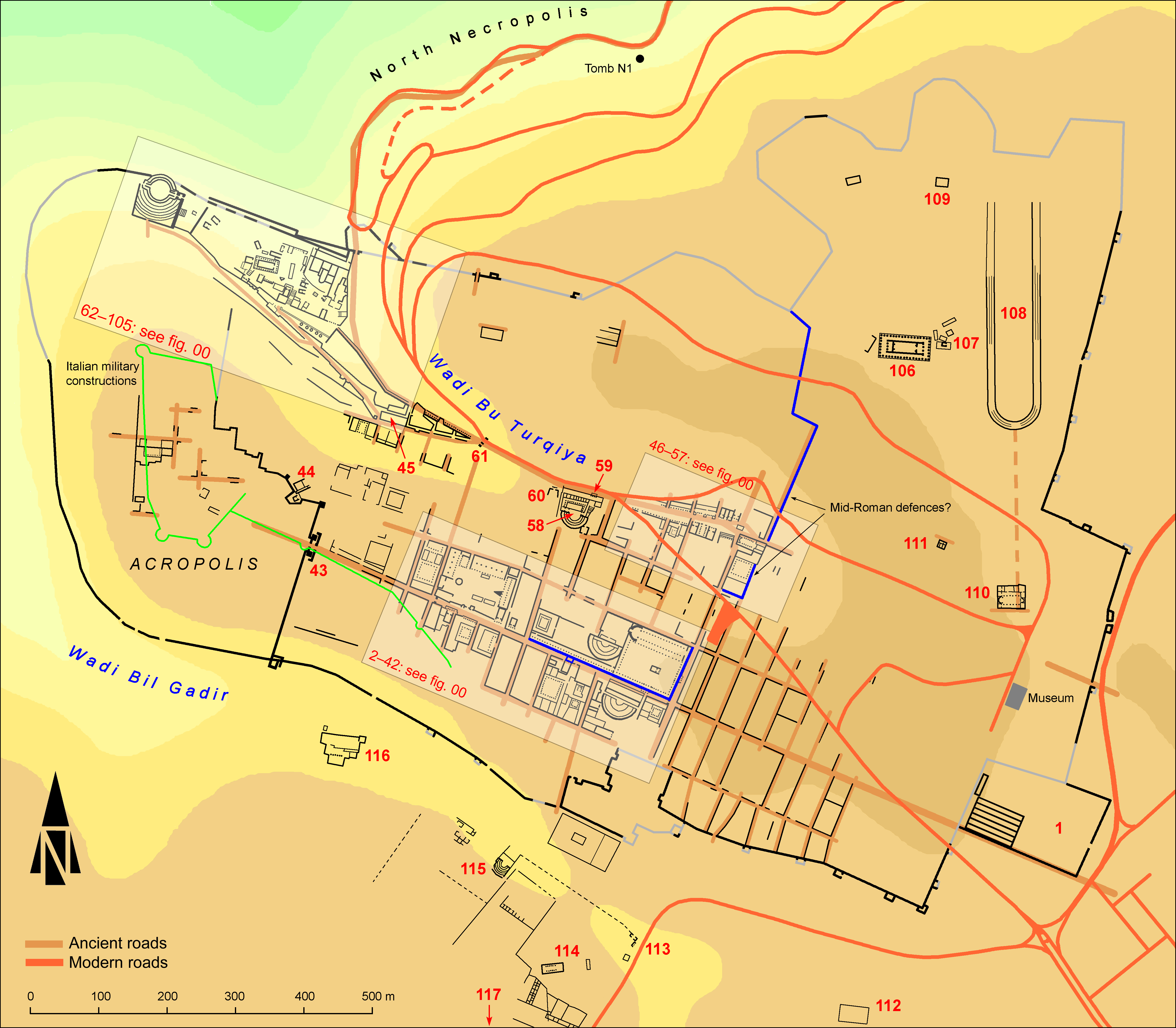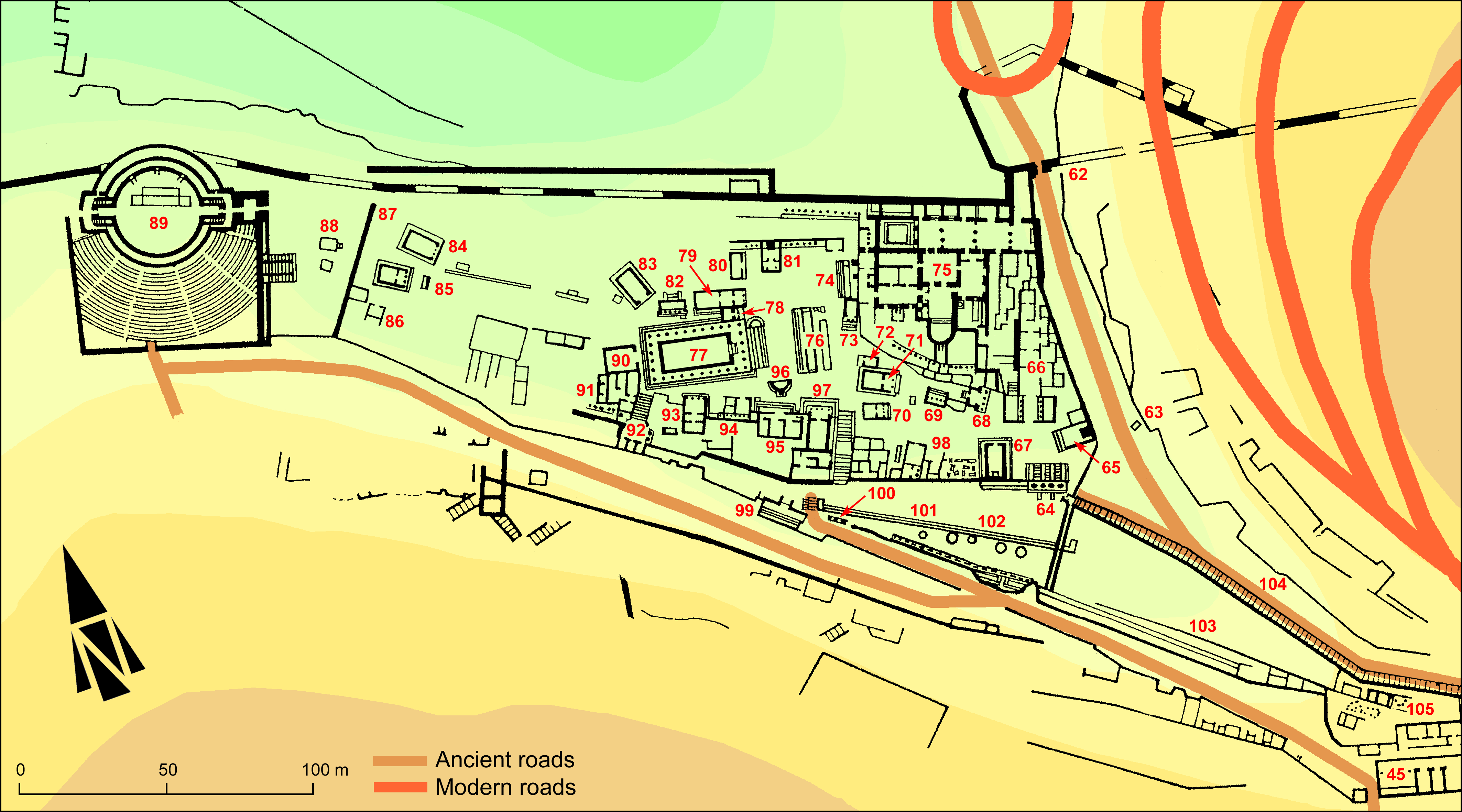EpiDoc XML:
IGCyr1007002
Trismegistos ID:
203019
Source description
Support: Two joining fragments of a white marble panel broken off at left and right (w: 0.18 × h: 0.205 × d: 0.045).
Layout: Inscribed in five lines on front face.
Letters: 0.02; slight serifs, alpha with dropped bar, omicron slightly smaller, non-slanting sigma, widely open upsilon.
Date: End of second or beginning of first century BC (lettering).
Findspot: Found in 1934 by G. Oliverio at Cyrene ➚: Sanctuary of Apollo, in a building near the Wall of Nicodamos.
Place of origin: Findspot.
Last recorded location: Museum of Libya, Tripoli, inv. number unknown. Seen by G. Pugliese Carratelli in 1960 at Tripoli: Museum of Libya. Seen by A. Laronde in 1978 at the same place. Not seen by IGCyr team.
Text constituted from: Transcription from previous editors.
Bibliography
Caputo 1947 (mention) and IRT2021, n. 848 (and preceding editions), both as from Tripolitania; Oliverio VI.64, whence SECir, 163; Luni 1976, n. 7; Dobias-Lalou, BE, 1988.1011; Marengo 1987, p. 307 (ph., dr.) and Dobias-Lalou, BE, 1989.832, whence SEG, 37.1674; Dobias-Lalou 2010, p. 165; IGCyr 100700 ➚.
Text
Apparatus
1: [c. 1 - 2]υ̣σανίου: [Πα]υσανίου Reynolds – Ward-Perkins 1952, IRT2009, IRT2021; [Λ]υσανίου Reynolds – Ward-Perkins 1952, IRT2009, IRT2021; [Πα]υ̣σανίου SECir
2: [γυμνασι]αρχήσας SECir: [---]αρχήσας Reynolds – Ward-Perkins 1952, IRT2009, IRT2021
3: [ἱαρὰς?]: [ἱερὰς?] Dobias-Lalou 2010; [νεὰς] Dobias-Lalou, BE Dobias-Lalou, BE, 1989.832; [τὰς] Marengo 1987; [χαλκᾶς] SEG Moretti's restoration per litteras; [---] Reynolds – Ward-Perkins 1952, SECir, IRT2009, IRT2021 || [ξ]ύστρας Marengo 1987: [---]ΥΣΤΡΑΣ Reynolds – Ward-Perkins 1952, SECir, IRT2009, IRT2021
4: [ὀγδ]οήκοντα Reynolds – Ward-Perkins 1952, IRT2009, IRT2021: [---]θ̣ήκοντα SECir || [Ἑρμᾶ]ι (vac. 1) Ἡρακλε[ῖ] SECir: [---τῶ]ι Ἡρακλε[ῖ] Reynolds – Ward-Perkins 1952, IRT2009, IRT2021; [Ἑρμᾶι κα]ὶ Ἡρακλε[ῖ] SEG Moretti's restoration per litteras
French translation
(scil. Untel) fils de [---]ysanias, après avoir exercé la gymnasiarchie (scil. a consacré) [comme biens des dieux] quatre-vingt strigiles à [ Hermès] et Héraclès.
English translation
(scil. So-and-so) son of [---]ysanias, after having been gymnasiarch, (scil. dedicated) [as sacred] eighty strigils to [Hermes] and Heracles.
Italian translation
(scil. Il tale) figlio di [---]ysanias, dopo essere stato ginnasiarco, (scil. ha dedicato) [come sacri] ottanta strigili a [Ermes] e a Eracle.
Arabic translation
(فلان) بن [---] يسانياس، بعد أن كان جمنازيارخ (مشرف بالجمنازيوم)، (أهدى) ثمانين مكشطاً[مقدسة] إلى [هرمس] وهيراكلس.
Commentary
Brought to Tripoli during World War II, this inscription has been kept there as if coming from Marsa Diba (or Dila) in North-Western Tripolitania, whence its mention by Caputo 1947 and its edition in Reynolds – Ward-Perkins 1952 and successive editions in 1952 and 2009. Pugliese Carratelli, not aware of the latter, published it at SECir, 163 from Oliverio's papers and apparently from his own observation at Tripoli. It was Marengo's merit at Marengo 1987 to fill the gap and definitely establish the findspot with the help of an unpublished excavation report. Another report mentioning the find is now available at Luni 2014, p. 147.This item should be definitively deleted from the future reeditions of the Tripolitanian collection.
The restoration of ἱαράς, proposed by C. Dobias-Lalou at line 3 is far from sure, but seems plausible to fit the gap; the adjective would have a predicative value, reinforcing the meaning of the subaudible verb of dedication. S. Marengo's restoration νέας gives a slightly different meaning: the gymnasiarch would have provided new strigils as a necessary duty of his charge. However this does not account for the aorist participle (he was then out of charge) nor for the act of dedication (why new strigils offered to the gods, whence useless ?) ; moreover the restored word seems rather short for the space available.
The father's name at line 1 calls to mind two names attested in Cyrenaica, either Pausanias or Lysanias. We cannot choose between them because we don't know how many letters are missing at the beginning of the name. Besides, there is a slight linguistic ambiguity about its ending, here at the genitive with -ιου, a form of koine if from Pausanias / Lysanias. Very few instances of the variants Pausanios / Lysanios are known from Rhodes. In fact, there is in this inscription no other distinctive feature leading to ascribe the text to the dialect. It seems thus better to decide that the text was in koine and the name had the normal ending in -ias.
CC BY-NC-SA 4.0 Deed Attribution-NonCommercial-ShareAlike 4.0 International License.
All citation, reuse or distribution of this work must contain a link back to DOI: https://doi.org/10.60760/unibo/igcyrgvcyr2 and the filename (IGCyr000000 or GVCyr000), as well as the year of consultation.


